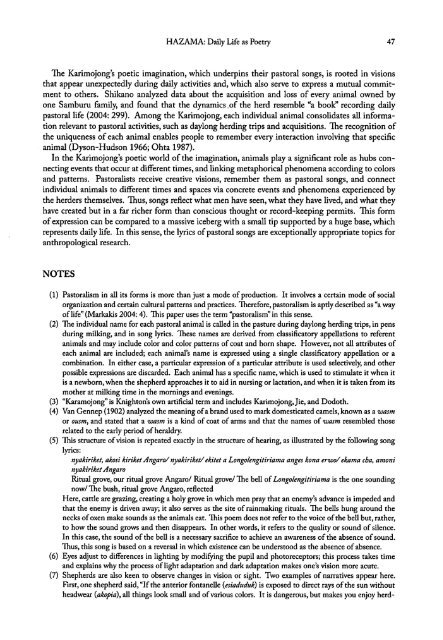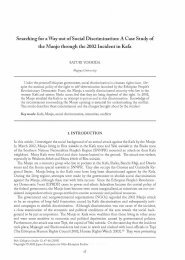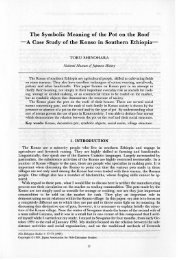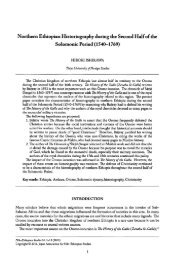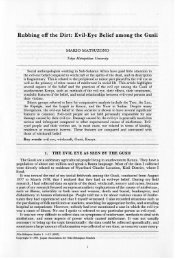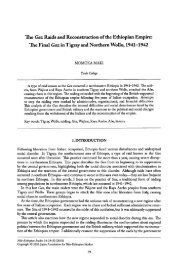Daily Life as Poetry: The Meaning of the Pastoral Songs of the ...
Daily Life as Poetry: The Meaning of the Pastoral Songs of the ...
Daily Life as Poetry: The Meaning of the Pastoral Songs of the ...
Create successful ePaper yourself
Turn your PDF publications into a flip-book with our unique Google optimized e-Paper software.
HAZAMA: <strong>Daily</strong> <strong>Life</strong> <strong>as</strong> <strong>Poetry</strong> 47<br />
<strong>The</strong> Karimojong's poetic imagination, which underpins <strong>the</strong>ir p<strong>as</strong>toral songs, is rooted in visions<br />
that appear unexpectedly during daily activities and, which also serve to express a mutual commitment<br />
to o<strong>the</strong>rs. Shikano analyzed data about <strong>the</strong> acquisition and loss <strong>of</strong> every animal owned by<br />
one Samburu family, and found that <strong>the</strong> dynamics .<strong>of</strong> <strong>the</strong> herd resemble "a book" recording daily<br />
p<strong>as</strong>toral life (2004: 299). Among <strong>the</strong> Karimojong, each individual animal consolidates all information<br />
relevant to p<strong>as</strong>toral activities, such <strong>as</strong> daylong herding trips and acquisitions. <strong>The</strong> recognition <strong>of</strong><br />
<strong>the</strong> uniqueness <strong>of</strong> each animal enables people to remember every interaction involving that specific<br />
animal (Dyson-Hudson 1966; Ohta 1987).<br />
In <strong>the</strong> Karimojong's poetic world <strong>of</strong> <strong>the</strong> imagination, animals play a significant role <strong>as</strong> hubs connecting<br />
events that occur at different times, and linking metaphorical phenomena according to colors<br />
and patterns. P<strong>as</strong>toralists receive creative visions, remember <strong>the</strong>m <strong>as</strong> p<strong>as</strong>toral songs, and connect<br />
individual animals to different times and spaces via concrete events and phenomena experienced by<br />
<strong>the</strong> herders <strong>the</strong>mselves. Thus, songs reflect what men have seen, what <strong>the</strong>y have lived, and what <strong>the</strong>y<br />
have created but in a far richer form than conscious thought or record-keeping permits. This form<br />
<strong>of</strong> expression can be compared to a m<strong>as</strong>sive iceberg with a small tip supported by a huge b<strong>as</strong>e, which<br />
represents daily life. In this sense, <strong>the</strong> lyrics <strong>of</strong> p<strong>as</strong>toral songs are exceptionally appropriate topics for<br />
anthropological research.<br />
NOTES<br />
(1) P<strong>as</strong>toralism in all its forms is more than just a mode <strong>of</strong> production. It involves a certain mode <strong>of</strong> social<br />
organization and certain cultural patterns and practices. <strong>The</strong>refore, p<strong>as</strong>toralism is aptly described <strong>as</strong> "a way<br />
<strong>of</strong>life" (Markakis 2004: 4). This paper uses <strong>the</strong> term "p<strong>as</strong>toralism" in this sense.<br />
(2) <strong>The</strong> individual name for each p<strong>as</strong>toral animal is called in <strong>the</strong> p<strong>as</strong>ture during daylong herding trips, in pens<br />
during milking, and in song lyrics. <strong>The</strong>se names are derived from cl<strong>as</strong>sificatory appellations to referent<br />
animals and may include color and color patterns <strong>of</strong> coat and horn shape. However, not all attributes <strong>of</strong><br />
each animal are included; each animal's name is expressed using a single cl<strong>as</strong>sificatory appellation or a<br />
combination. In ei<strong>the</strong>r c<strong>as</strong>e, a particular expression <strong>of</strong> a particular attribute is used selectively, and o<strong>the</strong>r<br />
possible expressions are discarded. Each animal h<strong>as</strong> a specific name, which is used to stimulate it when it<br />
is a newborn, when <strong>the</strong> shepherd approaches it to aid in nursing or lactation, and when it is taken from its<br />
mo<strong>the</strong>r at milking time in <strong>the</strong> mornings and evenings.<br />
(3) "Karamojong" is Knighton's own artificial term and includes Karimojong,Jie, and Dodoth.<br />
(4) Van Gennep (1902) analyzed <strong>the</strong> meaning <strong>of</strong> a brand used to mark domesticated camels, known <strong>as</strong> a w<strong>as</strong>m<br />
or ousm, and stated that a w<strong>as</strong>m is a kind <strong>of</strong> coat <strong>of</strong> arms and that <strong>the</strong> names <strong>of</strong> w<strong>as</strong>m resembled those<br />
related to <strong>the</strong> early period <strong>of</strong> heraldry.<br />
(5) This structure <strong>of</strong> vision is repeated exactly in <strong>the</strong> structure <strong>of</strong> hearing, <strong>as</strong> illustrated by <strong>the</strong> following song<br />
lyrics:<br />
nyakiriket, akosi kiriket Angarol nyakiriketl ekitet a Longolengitiriama anges kona erwo/ ekama cha, amoni<br />
nyakiriket Angaro<br />
Ritual grove, our ritual grove Angaro/ Ritual grove/ <strong>The</strong> bell <strong>of</strong> Longolengitiriama is <strong>the</strong> one sounding<br />
now/ <strong>The</strong> bush, ritual grove Angaro, reflected<br />
Here, cattle are grazing, creating a holy grove in which men pray that an enemy's advance is impeded and<br />
that <strong>the</strong> enemy is driven away; it also serves <strong>as</strong> <strong>the</strong> site <strong>of</strong> rainmaking rituals. <strong>The</strong> bells hung around <strong>the</strong><br />
necks <strong>of</strong> oxen make sounds <strong>as</strong> <strong>the</strong> animals eat. This poem does not refer to <strong>the</strong> voice <strong>of</strong> <strong>the</strong> bell but, ra<strong>the</strong>r,<br />
to how <strong>the</strong> sound grows and <strong>the</strong>n disappears. In o<strong>the</strong>r words, it refers to <strong>the</strong> quality or sound <strong>of</strong> silence.<br />
In this c<strong>as</strong>e, <strong>the</strong> sound <strong>of</strong> <strong>the</strong> bell is a necessary sacrifice to achieve an awareness <strong>of</strong> <strong>the</strong> absence <strong>of</strong> sound.<br />
Thus, this song is b<strong>as</strong>ed on a reversal in which existence can be understood <strong>as</strong> <strong>the</strong> absence <strong>of</strong> absence.<br />
(6) Eyes adjust to differences in lighting by modifying <strong>the</strong> pupil and photoreceptors; this process takes time<br />
and explains why <strong>the</strong> process <strong>of</strong> light adaptation and dark adaptation makes one's vision more acute.<br />
(7) Shepherds are also keen to observe changes in vision or sight. Two examples <strong>of</strong> narratives appear here.<br />
First, one shepherd said, "If <strong>the</strong> anterior fontanelle (esiaduduk) is exposed to direct rays <strong>of</strong> <strong>the</strong> sun without<br />
headwear (akopia), all things look small and <strong>of</strong> various colors. It is dangerous, but makes you enjoy herd-


